AARP Hearing Center

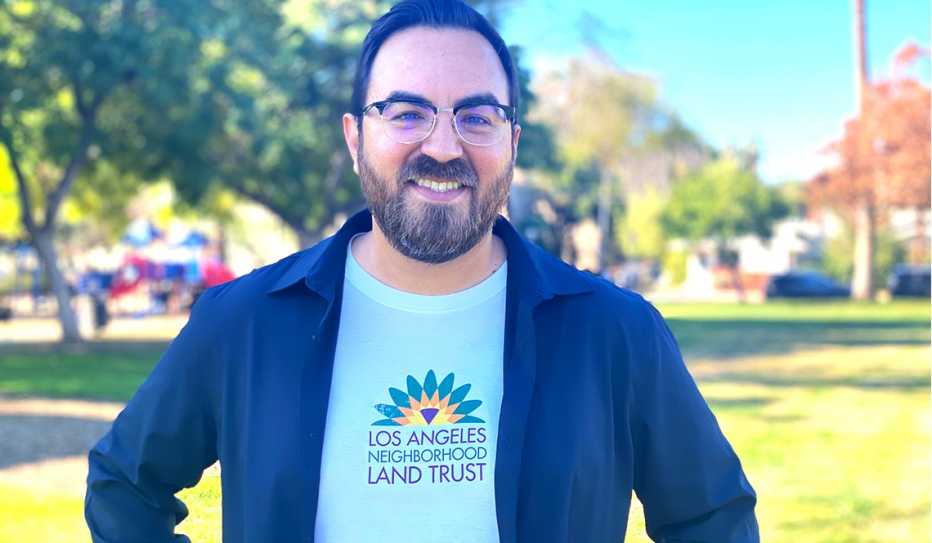
Jonathan Pacheco Bell is program manager of the Los Angeles Neighborhood Land Trust, a nonprofit that creates urban parks and gardens in underserved communities throughout the metropolitan area. Bell joined the organization in May 2020, after 13 years as an urban planner with the Los Angeles County Department of Regional Planning.
In his previous position, Bell developed a bottom-up approach he calls "Embedded Planning," on which he writes and lectures widely. This model calls for planners to embed themselves in stakeholders’ neighborhoods — spending ample time in their homes, businesses and places of worship; getting to know their families, cultures, struggles and dreams; and using techniques borrowed from community organizing to bring residents into the planning process.
Bell’s motto — “We cannot plan from our desks” — reflects his own lived experience.
Raised by his Mexican-American mother and grandmother on L.A.’s Eastside, he first expressed his artistic impulses by writing graffiti with a local crew. That awakened an urge to transform the built environment more fundamentally. After community college, Bell enrolled at the Southern California Institute of Architecture, but was put off by the air of privilege he found there. Transferring to Cal State Los Angeles, he earned a bachelor’s in political science. Then he looked for a way to merge his passions for design and social justice — which led to a master’s in urban planning from the University of California Los Angeles (UCLA).
Bell went to work for the county after grad school, enforcing zoning codes in South Central Los Angeles. In this low-income, mostly Black and Latino area, residents tended to see such regulations as just one more set of rules imposed by oppressive authorities.
“When I went to someone’s house, I would start a conversation about the planning process,” he recalls. “I wanted them to understand that it was meant to serve their interests, that it wasn’t something they had to be intimidated by. Even if I was serving them with a violation, I let people know I would work with them to solve the problem.”

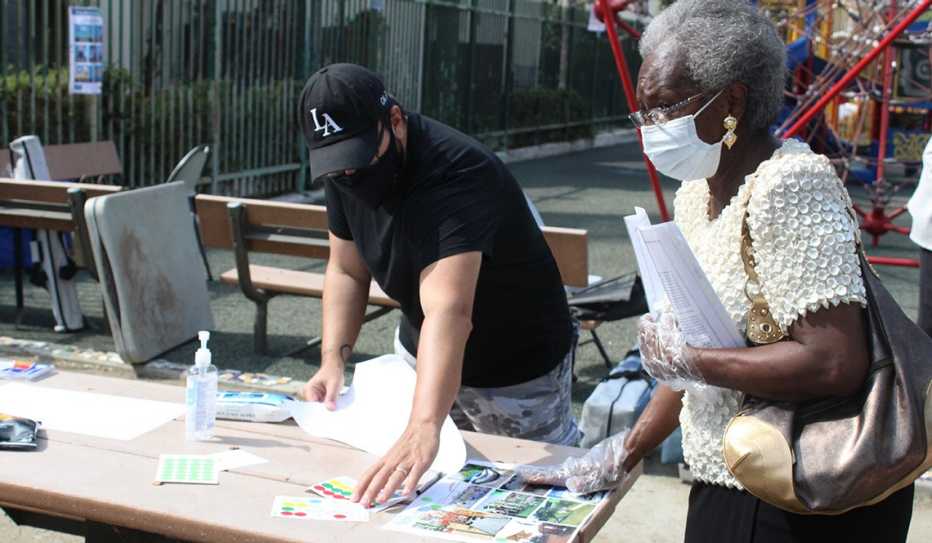
About the Los Angeles Neighborhood Land Trust
Founded in 2002, the Los Angeles Neighborhood Land Trust has helped create more than two dozen parks and gardens across Los Angeles County, serving 400,000 people living within a 10-minute walk of these green spaces.
The organization focuses its efforts exclusively in communities of color that have little to no access to parks and healthy outdoor places.
Mission: “To contribute to the equity and well-being of our neighborhoods through the development of parks, gardens, and community-driven organizing.”
Vision: "Our successful community development model engages residents from the beginning of our design process, through construction and ultimately the stewardship of the parks and gardens we create. We believe that inequity can be reversed by consistently practicing the values of sustainability, environmental justice, inclusivity, and collaboration. To ensure the long-term impact of our efforts, we are working towards equitable green space development through grassroots policy reform.”
Source: lanlt.org
Bell formed networks of alliances in the neighborhoods he covered, enabling him and his colleagues to craft ordinances that better reflected the needs of those who lived there. He also helped communities launch several improvement projects — including the transformation of a blighted stretch of land beneath high-power lines into the planned 92nd Street Linear Park.
When the leadership position at the Los Angeles Neighborhood Land Trust opened up, Bell saw an opportunity to promote change through design at a new level.
“I was familiar with their work to advance equity in the creation of parks and gardens in communities of color,” he says, “and I knew they were already doing their own version of Embedded Planning. It was like, this is where I need to be.”
AARP: What needs or challenges do you see as being the most important to residents of the communities your organization serves?
Bell: It starts with the lack of access to parks and gardens and open space in L.A. for communities of color. Los Angeles ranks 55th out of the 100 largest cities in the country for the number of people living within half a mile of a park. That’s especially true of lower-income neighborhoods, which also lack the private amenities — like rooftop gyms and backyard pools — that enable wealthier folks to combine outdoor exercise and socializing even if there isn’t a park nearby.
A related problem is a lack of affordable housing. You can see that rendered tragically in the high number of unhoused encampments in Los Angeles County right now. When new affordable housing is built, it often lacks green spaces. But when green spaces are created in low-income neighborhoods, they often attract outsiders looking for real estate bargains, leading to gentrification, which ends up displacing the community’s existing residents.
Our priority is to develop green spaces in a way that strengthens these neighborhoods instead of destroying them. As a community land trust, we buy land through the tax-default process, and then develop it in close partnership with the community. Our model is bottom-up, not top-down, which helps keep outside interests from influencing the way a park takes shape.
In about half of our projects, we continue to run the park after it’s built. When that’s the case, we hire folks from the neighborhood as park stewards. They're in charge of day-to-day operations. That helps send a message that the park belongs to the community, and that the community controls its destiny.
We also work on policy, advising the county on how to distribute public funding for green spaces in an equitable way. And we’re part of a coalition — called the Los Angeles Regional Open Space and Affordable Housing Collaborative, or LA ROSAH — that works on these issues. It’s a collaborative that brings together community land trusts, as well as nonprofit housing developers and environmental attorneys, to advance affordable housing and parks without gentrification.
AARP: The Los Angeles Neighborhood Land Trust received AARP Community Challenge funding to create the Golden Age Park in the Westlake/MacArthur Park neighborhood. How has the project advanced or addressed the vision for the community?


Bell: First, some background. Westlake/MacArthur Park is an extremely dense, low-income neighborhood with lots of apartments and multi-family housing. There are two large, city-owned green spaces in the area — MacArthur Park and Lafayette Park — but they’re beyond easy walking distance for many residents.
The site of Golden Age Park is about halfway between those parks. It had been a vacant lot for decades‚ a dumping ground and a nuisance. After we bought the property, we worked with the community to vision and design a park that would address their needs.
One priority that emerged was that the neighborhood has a high population of seniors. It also has a high population of young people. It was important to create a design that reflected both demographics. We partnered with researchers at UCLA’s Luskin School of Public Affairs to conduct focus groups with elders and their caregivers, which became part of a report called Placemaking for an Aging Population: Guidelines for Senior-Friendly Parks. We drew from those guidelines to create a park that incorporates age-appropriate, sensitive design for a senior population. So ...
- The park has flat walkways built with a stumble-proof material.
- The paths are laid out in a way that won’t be too confusing for folks who have dementia.
- There’s a low-impact exercise circuit, with stationary bikes and weight machines that are easy for older people to operate.
- The community garden has raised beds, so seniors don’t have to stoop so low.
- To make the site welcoming for young people, we invited children from the neighborhood to design decorative tiles, which we installed on the fence facing the street.
- We put in a play area for kids, situated where seniors can enjoy watching without having to worry about flying balls or tripping hazards.
- We also put in barbecue pits and shaded picnic areas, where folks from all generations can gather.
Another key element of Golden Age Park’s service to the community are the stewards. They open and close the park, greet users and keep an eye out to make sure everything is in good shape. Combined with the intimate scale of the park — about a third of an acre — this helps make it a place where folks feel safe and comfortable. (Scroll down to see before-and-after images of Golden Age Park.)
AARP: What do you see as the role of parks and other green spaces in a community?
Parks and gardens have always been spaces for communities to come together. They’re quite literally spaces for healing, because green spaces provide access to nature in highly urbanized places. Nature calms. Nature teaches. Nature rejuvenates.
All this has been especially evident with the pandemic, when we’ve been under quarantine and cooped up at home. Parks provide a place for socially distanced exercise and recreation and meeting up with friends and neighbors. If you need to talk to people, you can do that a little bit more safely outdoors.
For seniors, isolation was a danger even before COVID-19. In normal times, parks and community gardens are spaces where they can come and sit with friends or plant vegetables with their neighbors. During a lockdown, a park may be the only safe place to see family members who don’t live in their household.
I also want to mention the importance of reducing the urban heat island effect. In the neighborhoods we work in, there’s a lot of overcrowding, and people don’t always have effective air conditioning. In hot weather, being able to go to a park and sit in the shade can be a lifesaver.

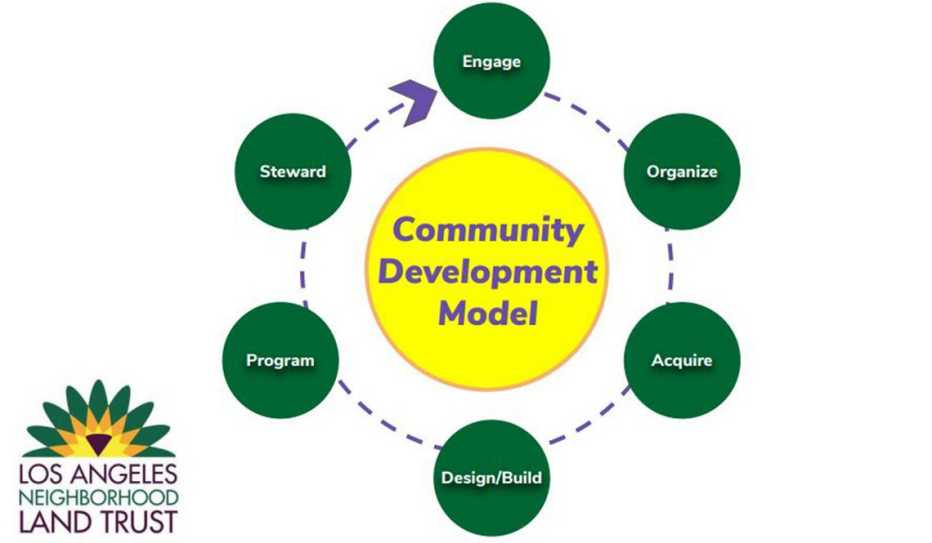
AARP: How does community engagement fit into the work you do — and what have you learned about it that you wish you’d known at the start of your career?
Our projects are designed by and for the communities they serve. That fosters a sense of ownership, which helps explain why we don’t have problems with people hogging the amenities or trashing things or being rowdy, as sometimes happens in other parks. Engagement is also central to the ongoing operation of our parks and gardens. We bring job creation with our green spaces, which are managed by the users themselves.
We operate a Park Equity Leadership Academy, or PELA, which provides community members with several weeks of training in urban planning, local government, urban agriculture and the importance of green space. Participants also learn the history of institutionalized racism, redlining and other land-use decisions that led to the problems that we have today. We often draw from PELA’s graduating classes for folks to become our stewards.
This whole approach reflects something I wish I’d known when I was just starting out — that it’s important to be unorthodox in community engagement. I’ve learned that we can’t rely solely on time-tested methods. We need to be bold and we need to be different.
One of my heroes is Ron Finley, who calls himself the Gangsta Gardener. In 2010, he dug up the parkway in front of his house in South Central — that strip of land between the sidewalk and the curb — and started planting fruits and vegetables. That was illegal, because the parkway belongs to the city. But Ron refused to comply with the notice of violation, and he got the city to change the ordinance. He went on to plant guerilla gardens in vacant lots throughout South Central and start a gardening training center for the community.
When I was a county planner, we connected, and he invited me over. As he was showing me his parkway garden, I said, “Oh, man, you were thinking outside the box.” And he said, “There is no box. Throw out that metaphor. Don’t constrain yourself to self-imposed boundaries.” His words continue to inspire me to this day, and so does his work.
AARP: The Purposeful Aging Los Angeles Initiative — a partnership between the county and the city of Los Angeles, other nearby cities, AARP, the private sector and universities — was formed in 2016 to help the region prepare for the dramatic demographic shift in the older adult population that will occur by 2030. What, if any, progress have you seen so far? And what, related to the work you focus on, do you want to see done going forward?
Bell: The Purposeful Aging Los Angeles Initiative makes eight recommendations aimed at enhancing the age-friendliness of the L.A. region. The one that’s specific to my work is No. 6: “Ensure county and city parks and other public spaces are age-friendly and culturally relevant.”
The initiative did a survey of residents’ perceptions of public space access in their part of the county — including the presence of safe, well-maintained parks with adequate benches to rest. Among older residents, non-Hispanic Whites were most likely to say their communities had age-friendly parks, with lower numbers among other ethnic groups, and percentages decreasing along with household income. To improve those statistics, the initiative recommended that new and existing parks incorporate guidelines like those in the UCLA report I mentioned earlier.
Thanks to the efforts of the Los Angeles Neighborhood Land Trust and other groups, L.A. is making progress toward that goal, but we’ve clearly got a long way to go. What I want to stress is that the need for safe, well-maintained parks isn’t just limited to seniors. Green spaces are good for people of all ages, and a lack of access hurts younger folks, too.
In my organizing work, I’ve come to understand the importance of solidarity — of bringing people into the fight, and finding commonality through shared values. As we fight for equity in outdoor spaces, we need to emphasize that this is something everyone, young or old, can get down with. We’ve got to reach out to people of every generation so our big-picture ideas don’t remain as just documents on a shelf.
Project: Golden Age Park
Located in the L.A. neighborhood of Westlake/MacArthur Park, the Golden Age Park project received grant funding from the AARP Community Challenge.
Before the park’s opening in December 2019, the site was vacant for nearly 30 years. Based on a design process led by community members, the space contains a community garden with raised-bed planters, shaded gathering areas, senior-friendly walking paths and a children’s play area and outdoor fitness equipment for older adults.
BEFORE: A trash-strewn vacant lot
The fenced, overgrown and littered lot at 739 S. Coronado Street had been vacant for 30 years.

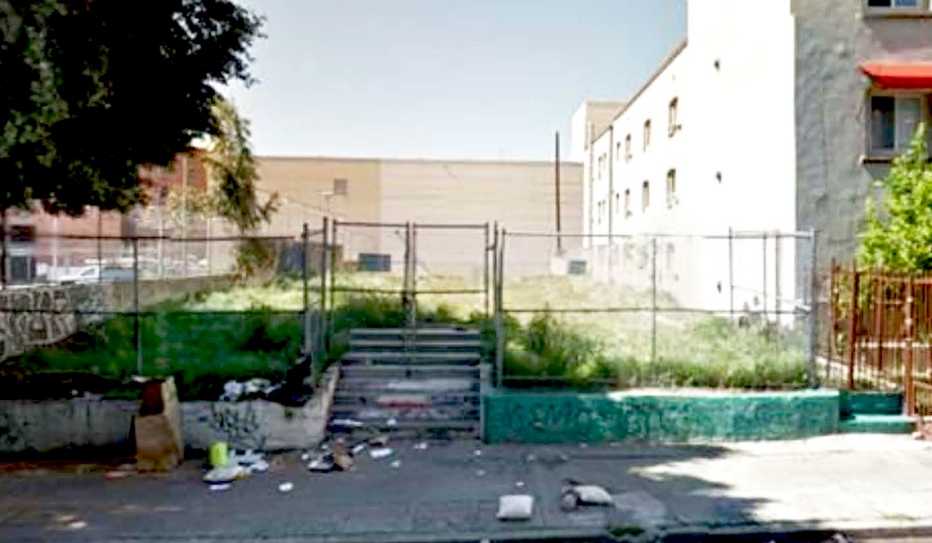
AFTER: The 7,500-square-foot Golden Age Park
The entrance to Golden Age Park. A statement on the park's signage reads "Health and Equity Rooted in Community Parks and Gardens." The small park provides visitors with places to sit in the sun or shade.

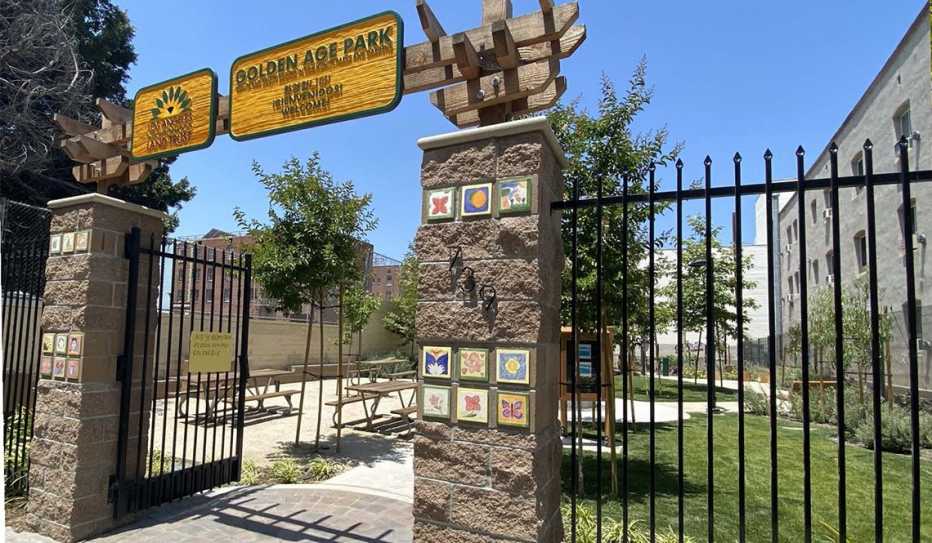


Jonathan Pacheco Bell was interviewed in December 2020 by Kenneth Miller, an award-winning writer and editor based in Los Angeles. His work has appeared in Time, Life, Esquire, Rolling Stone, Discover, Mother Jones, Salon, Reader’s Digest, Parade, Prevention, Los Angeles Times Magazine and many other publications.
































































